oil YAMAHA WR 450F 2007 Notices Demploi (in French)
[x] Cancel search | Manufacturer: YAMAHA, Model Year: 2007, Model line: WR 450F, Model: YAMAHA WR 450F 2007Pages: 794, PDF Size: 21.82 MB
Page 276 of 794
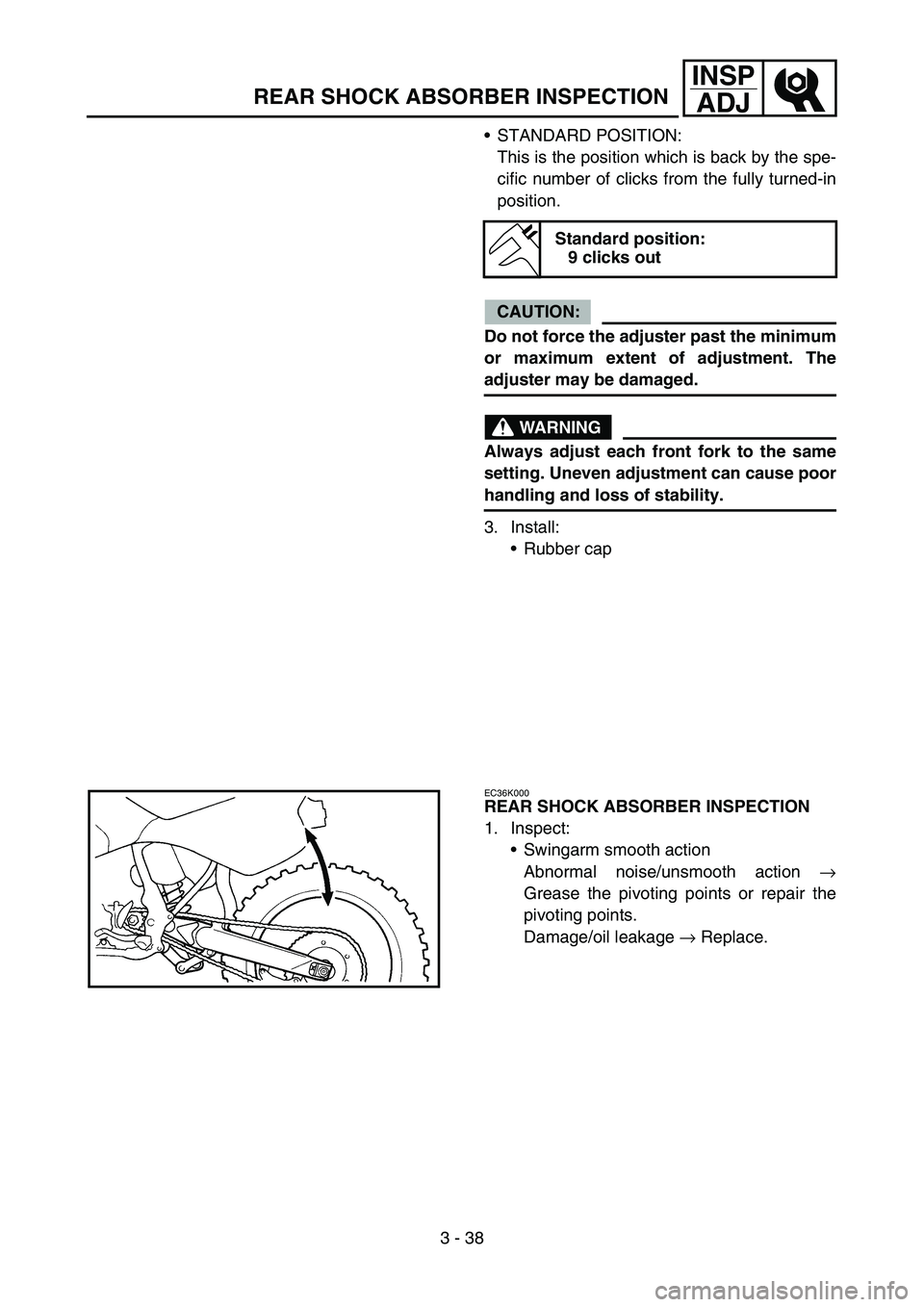
3 - 38
INSP
ADJ
REAR SHOCK ABSORBER INSPECTION
STANDARD POSITION:
This is the position which is back by the spe-
cific number of clicks from the fully turned-in
position.
CAUTION:
Do not force the adjuster past the minimum
or maximum extent of adjustment. The
adjuster may be damaged.
WARNING
Always adjust each front fork to the same
setting. Uneven adjustment can cause poor
handling and loss of stability.
3. Install:
Rubber cap
Standard position:
9 clicks out
EC36K000
REAR SHOCK ABSORBER INSPECTION
1. Inspect:
Swingarm smooth action
Abnormal noise/unsmooth action →
Grease the pivoting points or repair the
pivoting points.
Damage/oil leakage → Replace.
Page 287 of 794
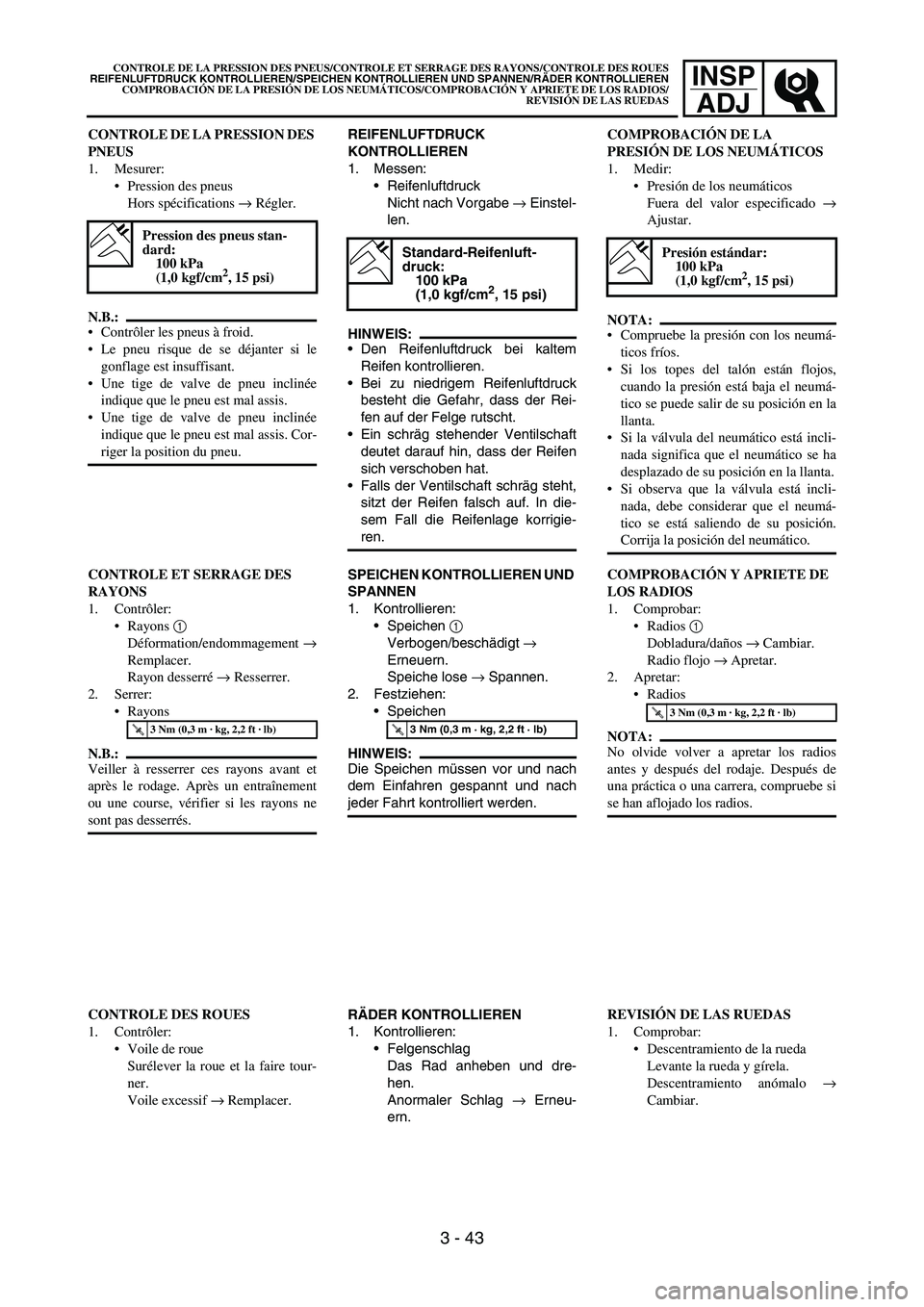
INSP
ADJ
CONTROLE DE LA PRESSION DES
PNEUS
1. Mesurer:
Pression des pneus
Hors spécifications → Régler.
N.B.:
Contrôler les pneus à froid.
Le pneu risque de se déjanter si le
gonflage est insuffisant.
Une tige de valve de pneu inclinée
indique que le pneu est mal assis.
Une tige de valve de pneu inclinée
indique que le pneu est mal assis. Cor-
riger la position du pneu.
Pression des pneus stan-
dard:
100 kPa
(1,0 kgf/cm
2, 15 psi)
CONTROLE ET SERRAGE DES
RAYONS
1. Contrôler:
Rayons 1
Déformation/endommagement →
Remplacer.
Rayon desserré → Resserrer.
2. Serrer:
Rayons
N.B.:
Veiller à resserrer ces rayons avant et
après le rodage. Après un entraînement
ou une course, vérifier si les rayons ne
sont pas desserrés.
T R..3 Nm (0,3 m · kg, 2,2 ft · lb)
CONTROLE DES ROUES
1. Contrôler:
Voile de roue
Surélever la roue et la faire tour-
ner.
Voile excessif → Remplacer.
CONTROLE DE LA PRESSION DES PNEUS/CONTROLE ET SERRAGE DES RAYONS/CONTROLE DES ROUES
REIFENLUFTDRUCK KONTROLLIEREN/SPEICHEN KONTROLLIEREN UND SPANNEN/RÄDER KONTROLLIEREN
COMPROBACIÓN DE LA PRESIÓN DE LOS NEUMÁTICOS/COMPROBACIÓN Y APRIETE DE LOS RADIOS/
REVISIÓN DE LAS RUEDAS
3 - 43
REIFENLUFTDRUCK
KONTROLLIEREN
1. Messen:
Reifenluftdruck
Nicht nach Vorgabe
→ Einstel-
len.
HINWEIS:
Den Reifenluftdruck bei kaltem
Reifen kontrollieren.
Bei zu niedrigem Reifenluftdruck
besteht die Gefahr, dass der Rei-
fen auf der Felge rutscht.
Ein schräg stehender Ventilschaft
deutet darauf hin, dass der Reifen
sich verschoben hat.
Falls der Ventilschaft schräg steht,
sitzt der Reifen falsch auf. In die-
sem Fall die Reifenlage korrigie-
ren.
Standard-Reifenluft-
druck:
100 kPa
(1,0 kgf/cm
2, 15 psi)
SPEICHEN KONTROLLIEREN UND
SPANNEN
1. Kontrollieren:
Speichen
1
Verbogen/beschädigt
→
Erneuern.
Speiche lose
→ Spannen.
2. Festziehen:
Speichen
HINWEIS:
Die Speichen müssen vor und nach
dem Einfahren gespannt und nach
jeder Fahrt kontrolliert werden.
T R..3 Nm (0,3 m · kg, 2,2 ft · lb)
RÄDER KONTROLLIEREN
1. Kontrollieren:
Felgenschlag
Das Rad anheben und dre-
hen.
Anormaler Schlag
→ Erneu-
ern.COMPROBACIÓN DE LA
PRESIÓN DE LOS NEUMÁTICOS
1. Medir:
Presión de los neumáticos
Fuera del valor especificado →
Ajustar.
NOTA:
Compruebe la presión con los neumá-
ticos fríos.
Si los topes del talón están flojos,
cuando la presión está baja el neumá-
tico se puede salir de su posición en la
llanta.
Si la válvula del neumático está incli-
nada significa que el neumático se ha
desplazado de su posición en la llanta.
Si observa que la válvula está incli-
nada, debe considerar que el neumá-
tico se está saliendo de su posición.
Corrija la posición del neumático.
Presión estándar:
100 kPa
(1,0 kgf/cm
2, 15 psi)
COMPROBACIÓN Y APRIETE DE
LOS RADIOS
1. Comprobar:
Radios 1
Dobladura/daños → Cambiar.
Radio flojo → Apretar.
2. Apretar:
Radios
NOTA:
No olvide volver a apretar los radios
antes y después del rodaje. Después de
una práctica o una carrera, compruebe si
se han aflojado los radios.
T R..3 Nm (0,3 m · kg, 2,2 ft · lb)
REVISIÓN DE LAS RUEDAS
1. Comprobar:
Descentramiento de la rueda
Levante la rueda y gírela.
Descentramiento anómalo →
Cambiar.
Page 294 of 794
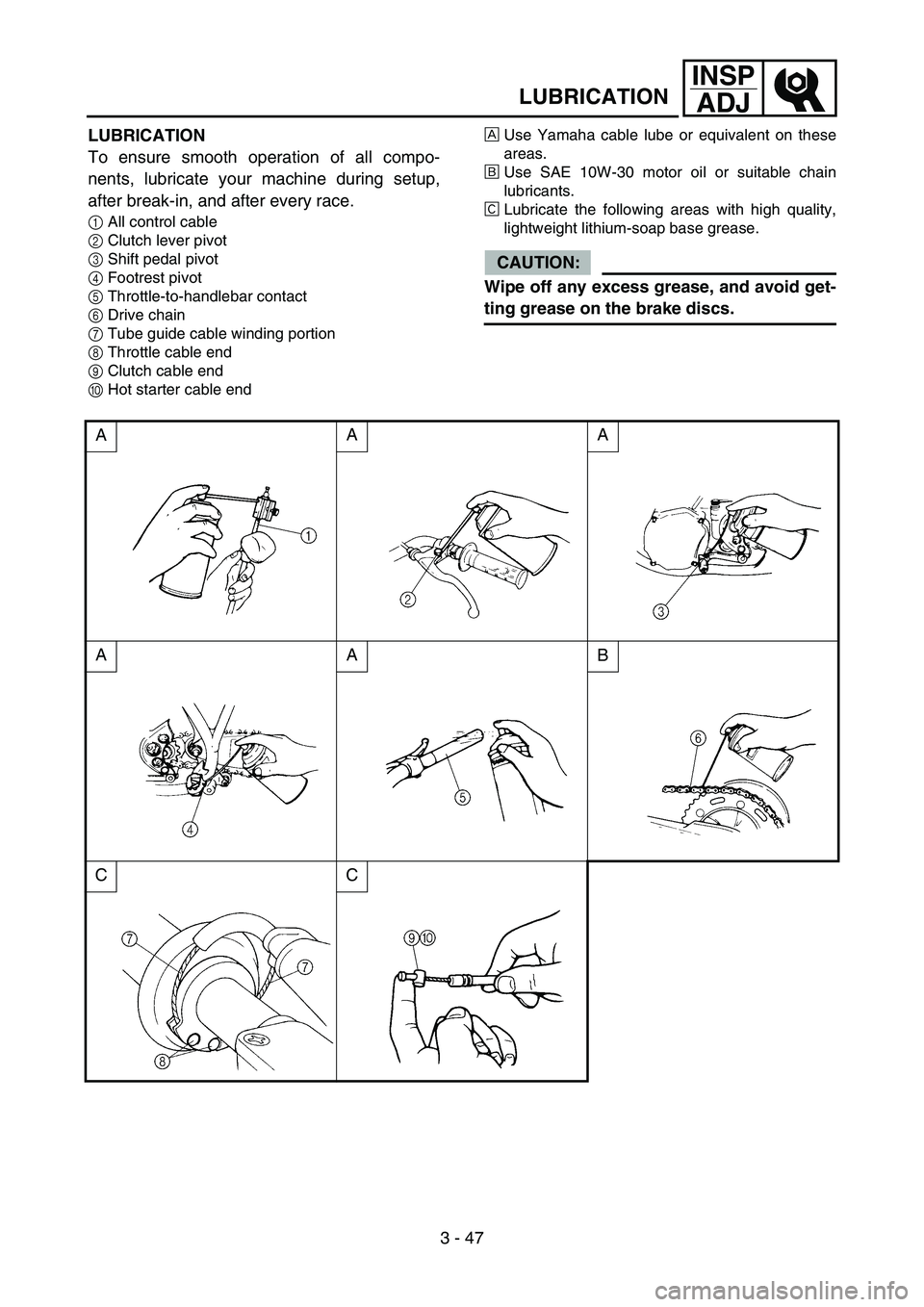
3 - 47
INSP
ADJ
LUBRICATION
LUBRICATION
To ensure smooth operation of all compo-
nents, lubricate your machine during setup,
after break-in, and after every race.
1All control cable
2Clutch lever pivot
3Shift pedal pivot
4Footrest pivot
5Throttle-to-handlebar contact
6Drive chain
7Tube guide cable winding portion
8Throttle cable end
9Clutch cable end
0Hot starter cable endÈUse Yamaha cable lube or equivalent on these
areas.
ÉUse SAE 10W-30 motor oil or suitable chain
lubricants.
ÊLubricate the following areas with high quality,
lightweight lithium-soap base grease.
CAUTION:
Wipe off any excess grease, and avoid get-
ting grease on the brake discs.
AAA
AA
B
CC
Page 298 of 794

3 - 49
INSP
ADJ
IGNITION TIMING CHECK
IGNITION TIMING CHECK
1. Remove:
Timing plug 1
1
2. Attach:
Timing light
Inductive tachometer
To the ignition coil lead (orange lead 1).
Timing light:
YM-33277-A/90890-03141
1
3. Adjust:
Engine idling speed
Refer to “IDLE SPEED ADJUSTMENT”.
4. Check:
Ignition timing
Visually check the stationary pointer a is
within the firing range b on the rotor.
Incorrect firing range → Check rotor and
pickup assembly.
5. Install:
Timing plug
Page 300 of 794
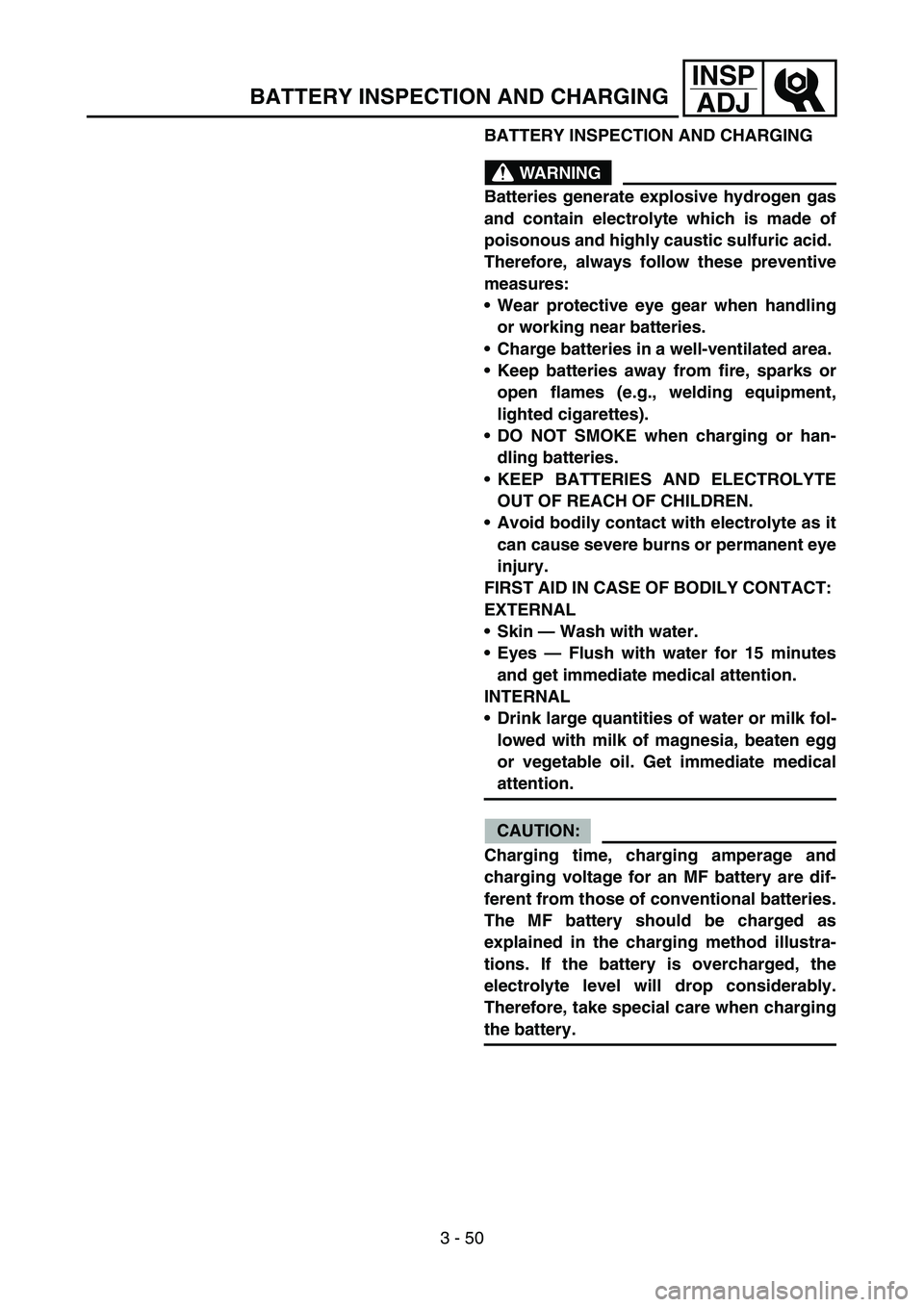
3 - 50
INSP
ADJ
BATTERY INSPECTION AND CHARGING
WARNING
Batteries generate explosive hydrogen gas
and contain electrolyte which is made of
poisonous and highly caustic sulfuric acid.
Therefore, always follow these preventive
measures:
Wear protective eye gear when handling
or working near batteries.
Charge batteries in a well-ventilated area.
Keep batteries away from fire, sparks or
open flames (e.g., welding equipment,
lighted cigarettes).
DO NOT SMOKE when charging or han-
dling batteries.
KEEP BATTERIES AND ELECTROLYTE
OUT OF REACH OF CHILDREN.
Avoid bodily contact with electrolyte as it
can cause severe burns or permanent eye
injury.
FIRST AID IN CASE OF BODILY CONTACT:
EXTERNAL
Skin — Wash with water.
Eyes — Flush with water for 15 minutes
and get immediate medical attention.
INTERNAL
Drink large quantities of water or milk fol-
lowed with milk of magnesia, beaten egg
or vegetable oil. Get immediate medical
attention.
CAUTION:
Charging time, charging amperage and
charging voltage for an MF battery are dif-
ferent from those of conventional batteries.
The MF battery should be charged as
explained in the charging method illustra-
tions. If the battery is overcharged, the
electrolyte level will drop considerably.
Therefore, take special care when charging
the battery.
BATTERY INSPECTION AND CHARGING
Page 320 of 794
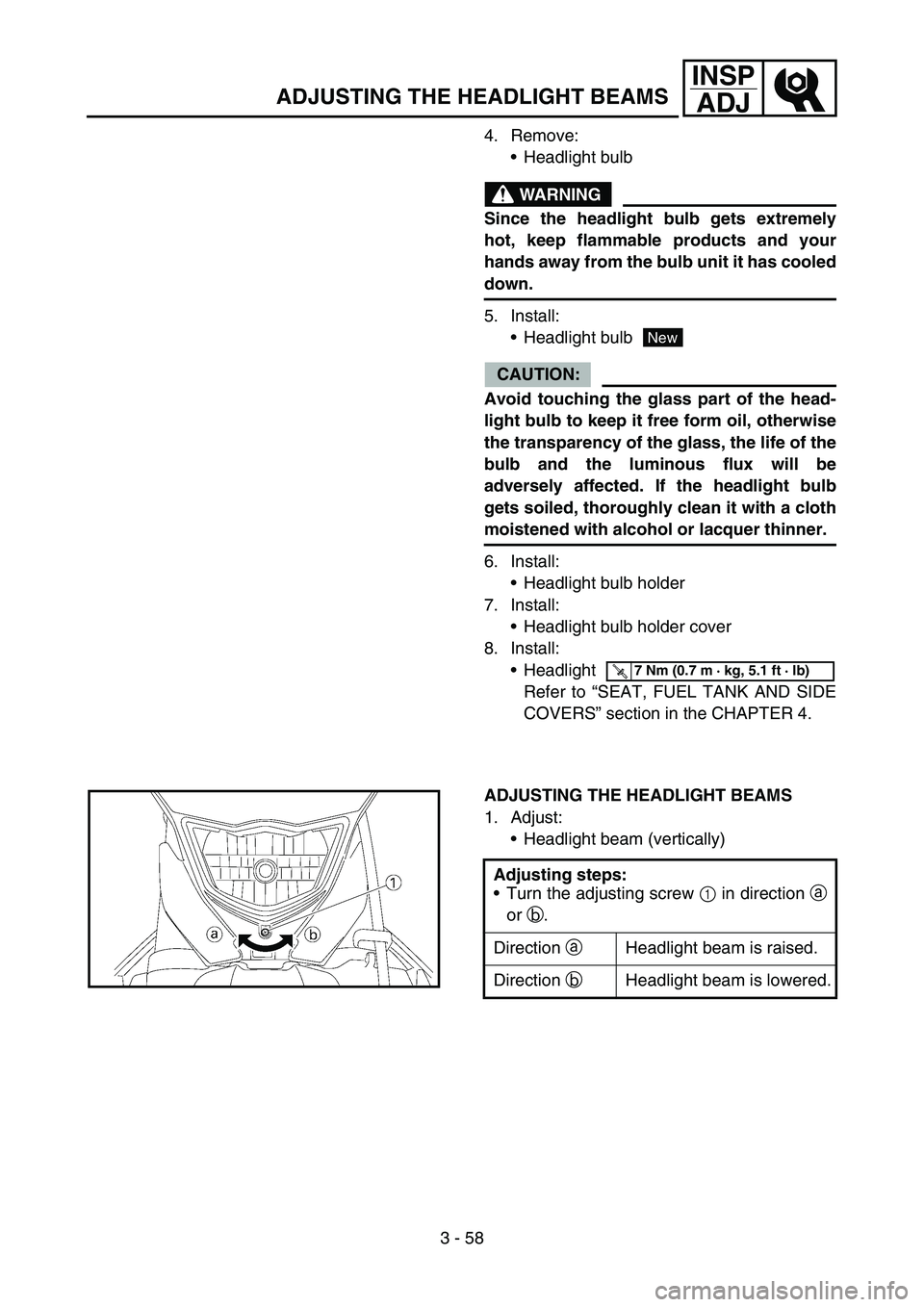
3 - 58
INSP
ADJ
ADJUSTING THE HEADLIGHT BEAMS
4. Remove:
Headlight bulb
WARNING
Since the headlight bulb gets extremely
hot, keep flammable products and your
hands away from the bulb unit it has cooled
down.
5. Install:
Headlight bulb
CAUTION:
Avoid touching the glass part of the head-
light bulb to keep it free form oil, otherwise
the transparency of the glass, the life of the
bulb and the luminous flux will be
adversely affected. If the headlight bulb
gets soiled, thoroughly clean it with a cloth
moistened with alcohol or lacquer thinner.
6. Install:
Headlight bulb holder
7. Install:
Headlight bulb holder cover
8. Install:
Headlight
Refer to “SEAT, FUEL TANK AND SIDE
COVERS” section in the CHAPTER 4.
New
T R..7 Nm (0.7 m · kg, 5.1 ft · lb)
ADJUSTING THE HEADLIGHT BEAMS
1. Adjust:
Headlight beam (vertically)
Adjusting steps:
Turn the adjusting screw 1 in direction a
or b.
Direction a Headlight beam is raised.
Direction bHeadlight beam is lowered.
Page 378 of 794

4 - 29
ENGCAMSHAFTS
Decompression system
1. Check:
Decompression system
Checking steps:
Check that the decompressor cam 1
moves smoothly.
Check that the decompressor lever pin 2
projects from the camshaft.
Timing chain tensioner
1. Check:
While pressing the tensioner rod lightly
with fingers, use a thin screwdriver 1
and wind the tensioner rod up fully clock-
wise.
When releasing the screwdriver by press-
ing lightly with fingers, make sure that the
tensioner rod will come out smoothly.
If not, replace the tensioner assembly.
ASSEMBLY AND INSTALLATION
1. Install:
Exhaust camshaft 1
Intake camshaft 2
Installation steps:
Turn the crankshaft counterclockwise until
the “I” mark a on the rotor is aligned with
the stationary pointer b on the crankcase
cover.
NOTE:
Apply the molybdenum disulfide oil on the
camshafts.
Apply the engine oil on the decompression
system.
Page 380 of 794
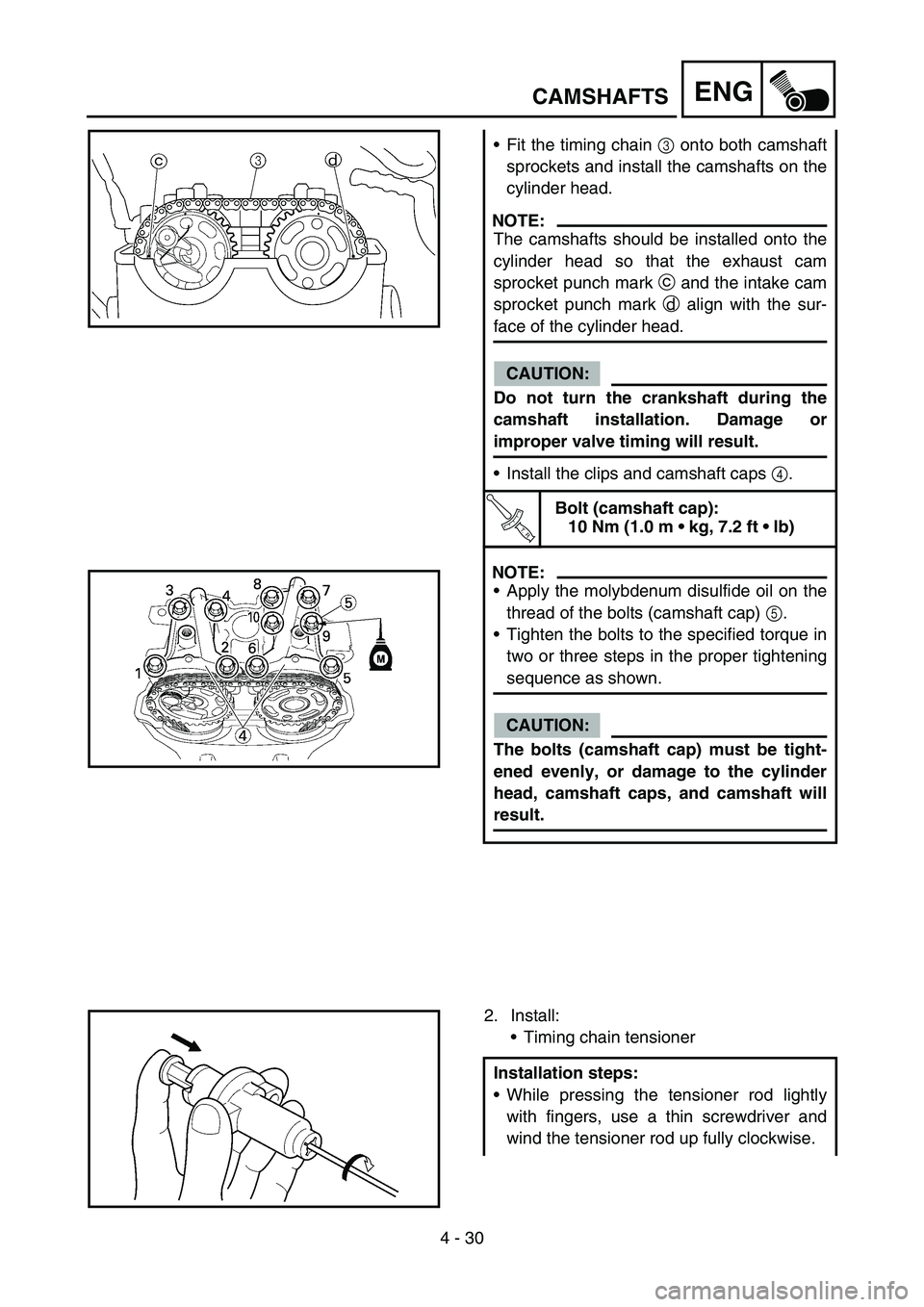
4 - 30
ENGCAMSHAFTS
Fit the timing chain 3 onto both camshaft
sprockets and install the camshafts on the
cylinder head.
NOTE:
The camshafts should be installed onto the
cylinder head so that the exhaust cam
sprocket punch mark c and the intake cam
sprocket punch mark d align with the sur-
face of the cylinder head.
CAUTION:
Do not turn the crankshaft during the
camshaft installation. Damage or
improper valve timing will result.
Install the clips and camshaft caps 4.
T R..
Bolt (camshaft cap):
10 Nm (1.0 m kg, 7.2 ft lb)
NOTE:
Apply the molybdenum disulfide oil on the
thread of the bolts (camshaft cap) 5.
Tighten the bolts to the specified torque in
two or three steps in the proper tightening
sequence as shown.
CAUTION:
The bolts (camshaft cap) must be tight-
ened evenly, or damage to the cylinder
head, camshaft caps, and camshaft will
result.
2. Install:
Timing chain tensioner
Installation steps:
While pressing the tensioner rod lightly
with fingers, use a thin screwdriver and
wind the tensioner rod up fully clockwise.
Page 402 of 794
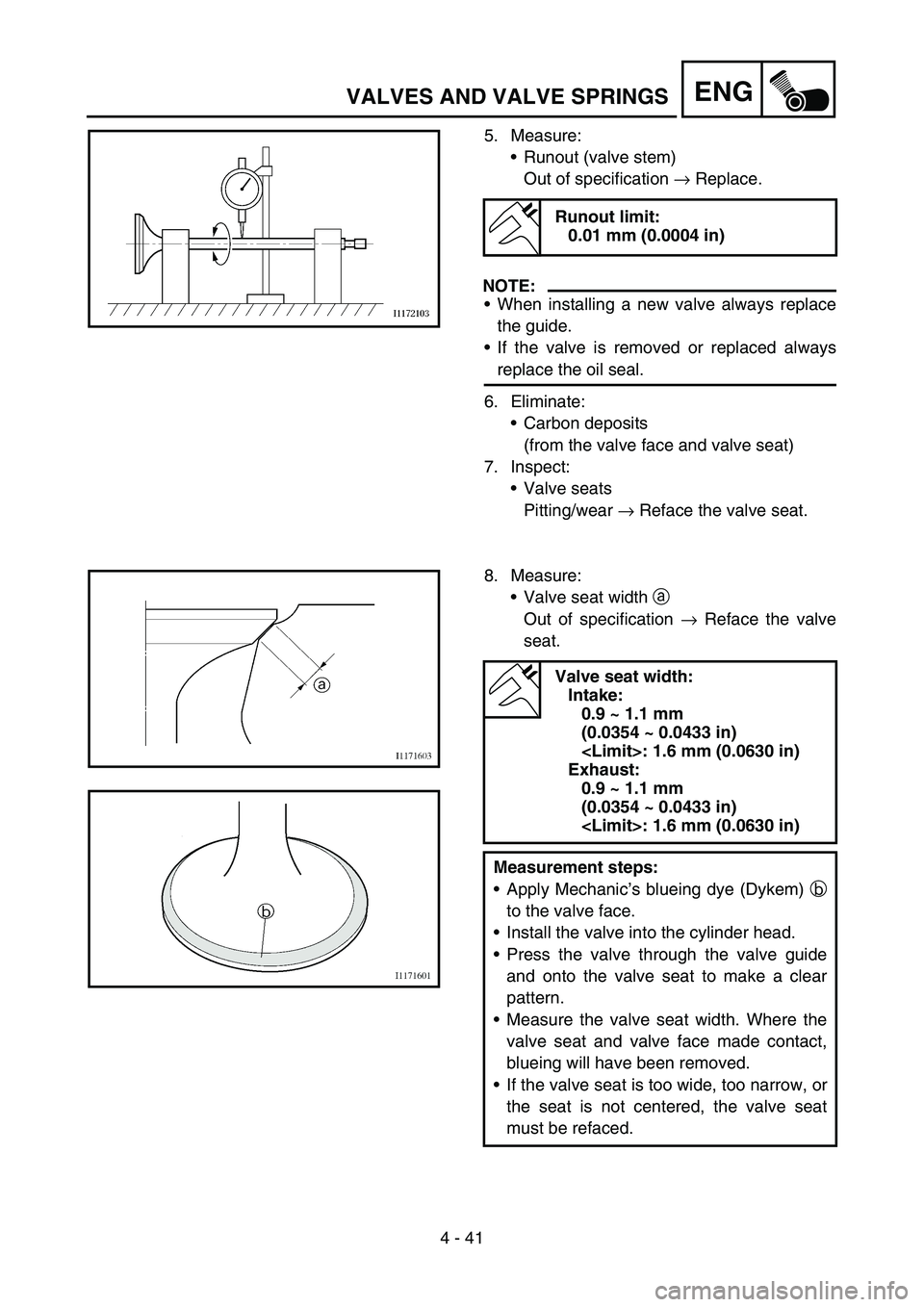
4 - 41
ENGVALVES AND VALVE SPRINGS
5. Measure:
Runout (valve stem)
Out of specification → Replace.
NOTE:
When installing a new valve always replace
the guide.
If the valve is removed or replaced always
replace the oil seal.
6. Eliminate:
Carbon deposits
(from the valve face and valve seat)
7. Inspect:
Valve seats
Pitting/wear → Reface the valve seat.
Runout limit:
0.01 mm (0.0004 in)
8. Measure:
Valve seat width a
Out of specification → Reface the valve
seat.
Valve seat width:
Intake:
0.9 ~ 1.1 mm
(0.0354 ~ 0.0433 in)
Exhaust:
0.9 ~ 1.1 mm
(0.0354 ~ 0.0433 in)
Measurement steps:
Apply Mechanic’s blueing dye (Dykem) b
to the valve face.
Install the valve into the cylinder head.
Press the valve through the valve guide
and onto the valve seat to make a clear
pattern.
Measure the valve seat width. Where the
valve seat and valve face made contact,
blueing will have been removed.
If the valve seat is too wide, too narrow, or
the seat is not centered, the valve seat
must be refaced.
Page 404 of 794
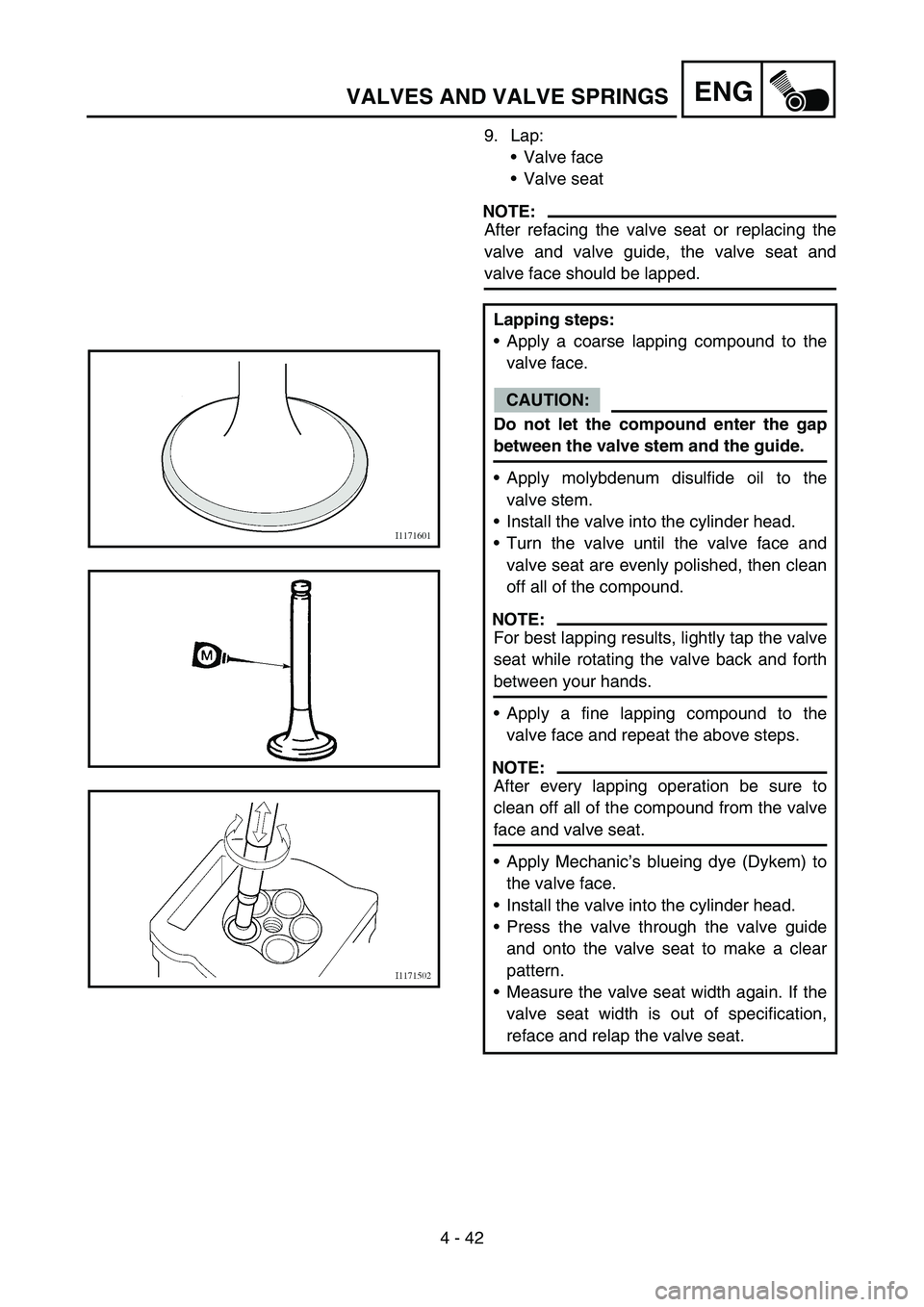
4 - 42
ENGVALVES AND VALVE SPRINGS
9. Lap:
Valve face
Valve seat
NOTE:
After refacing the valve seat or replacing the
valve and valve guide, the valve seat and
valve face should be lapped.
Lapping steps:
Apply a coarse lapping compound to the
valve face.
CAUTION:
Do not let the compound enter the gap
between the valve stem and the guide.
Apply molybdenum disulfide oil to the
valve stem.
Install the valve into the cylinder head.
Turn the valve until the valve face and
valve seat are evenly polished, then clean
off all of the compound.
NOTE:
For best lapping results, lightly tap the valve
seat while rotating the valve back and forth
between your hands.
Apply a fine lapping compound to the
valve face and repeat the above steps.
NOTE:
After every lapping operation be sure to
clean off all of the compound from the valve
face and valve seat.
Apply Mechanic’s blueing dye (Dykem) to
the valve face.
Install the valve into the cylinder head.
Press the valve through the valve guide
and onto the valve seat to make a clear
pattern.
Measure the valve seat width again. If the
valve seat width is out of specification,
reface and relap the valve seat.